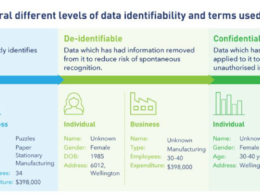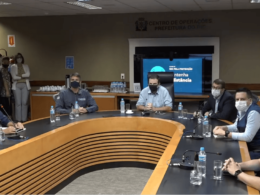Medium
Alastair Allen
Football fan and CTO @Better Previously CTO @Kainos
January 7, 2022
It is just over ten years since Marc Andreesen wrote his famous piece, Why Software is Eating the World?
He reflected on how more and more businesses and industries were being run on software and delivered as online services.
He predicted that new software companies would disrupt more and more industries through innovative new software over the next ten years.
Ten years later, I think it is fair to say he was right — with perhaps more disruption (and more challenges) than he ever predicted.
However, within healthcare, it has been a case of “Gradually, then Suddenly” — with little innovation or disruption for years, until COVID-19 came along and necessity became the mother of invention.
Over the past 18 months, I have been directly involved in supporting a small part of the NHS’s response to COVID-19 through Kainos’ work on remote consultations and the services they delivered for COVID-19 Testing, Contact Tracing and Vaccinations.
I have seen first-hand how innovation has been ignited, processes have been optimised, and hurdles have been safely removed.
Things that used to take months were completed in weeks, sometimes days.
… within healthcare, it has been a case of “Gradually, then Suddenly” — with little innovation or disruption for years, until COVID-19 came along and necessity became the mother of invention.
Coronavirus has shaped the future of innovation in healthcare. No one I have spoken to wants to go back to how we did things before.
Coronavirus has shaped the future of innovation in healthcare. No one I have spoken to wants to go back to how we did things before
There will be many elements to maintaining this innovative approach — from people and processes to technology. But there is one foundational piece that I believe will play a crucial role.
openEHR. (Pronounced “open-air”).
More and more healthcare systems are turning to openEHR — from individual hospitals to regions to entire countries.
I believe we are at a similar junction now with openEHR as we were with software in 2011.
But, just as with software then, we can see that the tide is turning, momentum is growing, and disruption is coming.
Over the next ten years, I expect many more healthcare systems to separate their applications from their data, putting openEHR at the centre of their architecture.
Doing so will allow them to establish entire ecosystems of disruptive and innovative services centred around the patient.
Over the next ten years, I expect many more healthcare systems to separate their applications from their data, putting openEHR at the centre of their architecture.
Doing so will allow them to establish entire ecosystems of disruptive and innovative services centred around the patient.
Why is this happening?
Because openEHR will make healthcare integration obsolete, accelerating digital transformation.
Most software applications, including those in healthcare, have app-centric architectures, where the data for the app is stored as an integrated part of the application, each responsible for storing, protecting, auditing and sharing the data for their app.
However, it will come as no surprise to many that within any healthcare system there is never just one application.
This means we typically end up with lots of data — often duplicated — stored across many applications, oftentimes in a closed, proprietary format.
The traditional approach to making all these applications speak to one another lies in what I believe is an over-used buzzword.
Interoperability.
Typically, people associate this term with API’s or ETL’s that move data between systems to support the needs of one or more applications.
However, healthcare organisations have been wrestling with this idea of interoperability for years, which is understandable — stitching together an entire healthcare system in this way with 100’s of applications is highly complex and challenging.
- Take the NHS, for instance. Billions were primarily wasted on the IT plans of the early 2000s.
In 2012 the Department of Health published a new digital strategy, which was followed in 2014 with an updated plan to work alongside the NHS five year forward view.
In 2016 the Data and Information Strategy was published by NHS Digital.
These strategies all had various levels of interoperability ambition, but despite this work, I think it is fair to say the NHS is not yet “interoperable”.
Pleasingly, the most recent NHS Data Strategy published this year appears to be responding to some of these experiences and is proposing a different approach, where data is separated from applications. More on that later.
Why is openEHR different?
penEHR still enables a system to be “interoperable”, federated, and use standards-based API’s to interact with data, but it moves the entire landscape from an app-centric architecture to a data-centric one.
In making this shift, it eliminates data silos, removes point to point integrations between applications and provides a composable architecture that accelerates development.
In the recent information architecture paper from EY, they illustrate this concept really well with the following diagram.
Healthcare organisations considering this shift will need to carefully evaluate how they will manage their data, especially if it will be at the centre of their architecture.
- First, they will be making a strategic, long-term decision, so they will not want to be tied to one vendor. ]
- Second, they will be working with complex healthcare data, so they will want something that embraces this complexity and allows information to be precisely defined.
- Finally, they will be establishing an ecosystem of applications around the data, so they will need a robust modelling framework that encourages agility and re-use.
openEHR addresses each of these considerations as a core part of its design.
- It has an open architecture, allowing patient-centric information to be stored in a vendor-neutral format that is long-lived, versioned, and easily computable.
- Second, it has a semantic architecture, allowing the meaning of health and care information to be precisely defined.
- Finally, it has a robust modelling framework, where domain models are created by domain experts (such as clinicians) and are separated from technical layers, leading to greater agility and re-use.
I believe this data-centric approach — implemented using openEHR — will allow an eco-system of intuitive, user-centred applications to emerge.
It will also enable innovation in clinical research, digital therapeutics, disease prevention and population health management — leveraging complementary standards such as FHIR, OMOP CDM and patterns such as Data Mesh.
These are some of the reasons why I believe openEHR will make a difference. But it is not just me.
There are many examples across the world of where it is being adopted.
- Perhaps the most recent and high-profile example of this is the Catalonia Health Service.
They plan on using openEHR for its new platform for health records across the entire region of Catalonia. The announcement highlights that its current system for sharing information is a “ barrier to the systematic use of health data”, with “ semantic interoperability being probably the biggest problem “.
- In London, a £3.1m contract was recently announced to provide a shared care planning solution for London.
This solution will “ Establish… a platform of persistent data with openEHR coupled with a low code environment for health and care professionals to dynamically evolve digital care planning services”.
- In Wales, Digital Health and Care Wales (DHCW) has announced a contract to implement a clinical data repository …
that will form a “ constituent part” of their national architecture and will “ help to transform care and treatment for patients “.
- In Slovenia, the Slovenian Ministry of Health has been using openEHR since 2012, …
establishing national interoperability services across the country. They have recently leveraged this platform to deliver a national COVID-19 screening solution in just 14 days.
- In Moscow City, over 670+ healthcare providers use an openEHR platform to manage the health and social care records for its 12.6+ million citizens.
- In the NHS, the most recent Data Saves Lives strategy outlines a commitment to “ separate the data layer from the application layer [to provide] a standardised… cleansed dataset”.
They go on to say this will allow data to “ be more easily accessed and analysed [enabling] innovation to take place securely and openly on top of the data “.
This view is now also shared by consultancies like EY and Gartner. For example, in EY’s information architecture paper, they discuss “ a cohesive technology stack, giving a unified experience for clinicians, professionals and patients and an extensible, vendor-neutral data layer at the centre, accessed by all applications in real-time “.
Still, we face some challenges — three of which I outline below
First of all, there is a view from many CIO’s and healthcare leaders that there are no applications that run on top of openEHR, creating a perception they would have to build everything themselves.
The good news is there is an ever-growing ecosystem of applications, which I expect will accelerate over the next ten years. In the Nordics, for example, all four of the leading EHR vendors run applications that are based on openEHR. This includes Norway (DIPS, PatientSky), Sweden (Cambio) and Finland (TietoEvry). Outside of the EHR space, there are a growing number of specialist applications, including those for e-prescribing, care planning, and e-observations.
I also believe we are entering the next generation of software development, where no-code/low-code applications will allow citizen developers to quickly build applications safely, using platforms developed and managed by programmers and platform engineers. The biggest challenge surrounding the adoption of these platforms in healthcare has typically been dealing with the complexity of healthcare data, which constrains all but the simplest of use cases. However, we are starting to see specialist low-code platforms explicitly designed to run on openEHR, such as the Better low-code environment recently selected by Christie NHS Foundation Trust. These platforms have the genuine potential to give healthcare organisations the tools needed to support the innovation precedent set by COVID, i.e., working closely with users to solve problems quickly and safely.
Secondly, there is rarely a “greenfield” opportunity where CIOs and healthcare leaders only need to think about their target state architecture without considering what they have now and how they get to where they want to be.
Often the thought of shifting from an existing (and often complex) app-centric architecture to a future state data-centric architecture can be overwhelming.
This challenge is not unique to healthcare. I’ve seen many organisations across various industries embark on legacy modernisation journeys throughout my career. While there is no silver bullet and each organisation will take a different approach, the good news is there are lots of people who have done this before.
Many great patterns ( Patterns of Legacy Displacement, StranglerFig, The Postmodern EHR) help guide those setting out on their journey. Again, EY does an excellent job of visualising this transition using the graphic shown below.
The key message here is to re-use existing assets, not be limited by them.
Where new applications are being introduced, it makes sense to adopt a data-centric approach from the start. However, where existing applications are in place, incrementally move towards a data-centric architecture leveraging tools such as API management to support an intermediate state of co-existence between your current state and target state architectures.
The alternative option of standing still is — I believe — not an option. In this era of constant change, your existing app-centric system will start to hold you back, shackling you from achieving your goals.
In his article on Legacy modernisation, Ashok Subramanian from ThoughtWorks urges us to “ change before you have to”, going on to reflect, “ You have to find a way to disrupt yourself before someone, or something else disrupts you “.
Finally, over the last number of years, there have been many headlines and much attention surrounding FHIR.
Much of this has been well deserved, and I’m an advocate for FHIR, where it is used in the right way. However, the challenge emerges when people believe FHIR and openEHR are competitive standards that do the same thing. At best, this leads to confusion; at worst, it leads to bad design decisions impacting implementations. Nevertheless, I believe there is a place for both standards to be used in a complementary way — I’ve published my thoughts on this here.
This view is also shared by the Open Data Institute who recently published the “Data Governance Playbook” for healthcare.
Overall, it is a great paper — which I would encourage anyone working in this space to read — but the section on interoperability does a great job of presenting the range of healthcare standards available and how they can be used together to solve customer problems. They include FHIR for data exchange and openEHR for electronic healthcare records, alongside other standards such as ICD11, Snomed CT and OMOP.
It was also amazing to be part of the recent HiGHmed symposium in Berlin, where vendors and healthcare leaders shared their perspectives on how these two standards can complement one another. The slides and talks from this important event are now available online at this link.
I’m privileged to now work at Better, one of the best software companies to adopt the openEHR standard.
I have admired them for some time, but having now started working with them, even in just a short period of time, I can tell you they’re really great at what they do.
I believe they will continue this great work, providing a best-in-class Digital Health Platform that will accelerate digital transformation in health and care — underpinned by data for life.
So, instead of being held back by the scars of the past or perceived challenges of the future, let’s seek to understand the benefits of a new data-centric architecture.
Then, let’s work back from this to identify how we can iteratively move in that direction and use this approach to transform healthcare through improved experiences for health and care teams and the delivery of better outcomes for patients.
To quote Marc Andreesen, “ That’s the big opportunity. I know where I’m putting my money “.
Originally published at https://medium.com on January 7, 2022.
TAGS: OpenEHR; Digital Health Systems Failures; EHR; OpenEHR, Trends in Health Care; Interoperability; Health IT issues; Vision Of The Future












